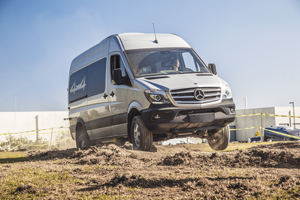Mercedes Rolls Out 4x4 Sprinter to Boost Van Presence in North America

Claus Tritt, general manager of commercial vans for Mercedes-Benz USA, said U.S. sales for the Sprinter through September were 17,725 units, up almost 19% from a year earlier. The construction sector accounts for about 60% of the customer base.
With the 4x4 option, “we believe we can enhance our position in this segment,” Tritt said during an Oct. 27 media briefing at the Sprinter reassembly plant in Ladson, South Carolina.
Days earlier, Volker Mornhinweg, head of Daimler AG’s global van division, said in a statement that Mercedes will “produce the next generation of the Sprinter in North America.”
He added: “As the market leader, we must also take into account the future worldwide growth of the Sprinter’s segment. However, we can cover the growing demand for large vans in the North American market economically only if we produce the vehicles locally in the Nafta region.”
Tritt declined additional comment when asked about Mornhinweg’s statement.
Globally, Mercedes sold just over 270,000 vans in 2013, a figure Tritt said “will be growing in 2014.”
The United States is the Sprinter’s second-largest market, with about 23,000 delivered last year. Germany is the No. 1 market.
Through the third quarter of 2014, U.S. market share for Sprinters was 7.8%, a small gain from a year earlier. The van segment is dominated by Ford Motor Co., which has a 43% share but has lost ground during 2014. Chevrolet is second at 28.9%, and GMC is at 10.9%, according to IHS Polk.
These vans, with cargo capacity generally topping out at about 11,000 pounds, are used widely by tradesmen, delivery companies and retailers.
Earlier this year, Ford rolled out a full-size Transit, a more European-style long, narrow van — and promoted it in television commercials in recent weeks. To counter that move, Mercedes showed journalists its first Sprinter television commercial set to debut this month.
Tritt also said parcel delivery makes up 15% of sales. While declining to cite FedEx Corp. by name, he alluded to the decision by the large airfreight and parcel delivery company based in Tennessee to order thousands of Sprinters in recent years.
“Every cent counts because the margins are so low,” Tritt said of the package delivery segment and the fuel-economy benefits Sprinters can offer.
The 2014 Sprinter comes standard with a turbocharged 4-cylinder diesel engine and 7-speed automatic transmission, which has boosted fuel economy about 18% over the now-optional 6-cylinder, 5-speed transmission.
The reassembly plant features far less automation and robotics than the Dusseldorf, Germany, location of the main Sprinter factory that turns out about 150,000 vans annually. All Sprinters for the U.S market arrive through the nearby Port of Charleston. The passenger models are shipped as complete vehicles, but the cargo models are broken down in order to avoid U.S. tariffs as high as 25%.
The tariffs, known as the “chicken tax” because they were started in 1963 to protect U.S. chicken production, included light trucks.
After a truck drops a cargo container at the plant, cargo models — generally two per box — are backed into the plant’s unloading area. Once on the factory floor, it begins a process that takes three to four hours. The powertrain, fuel tank and battery are reinstalled, along with the wheels. Once complete, it is loaded onto a vehicle hauler for distribution — or transfer to freight trains.
Excluding the front end, Mercedes- and Freightliner-brand models are nearly identical. They are reassembled simultaneously; the only difference is which grille and nameplate is installed.
Currently, the plant reassembles between 66 and 76 Sprinters each day over one shift. There are 90 hourly workers at the plant and 30 salaried employees. Company officials said they expect to soon add a second shift in response to growing demand. There previously was a second shift at the plant, which has been building Sprinters since 2006. It was eliminated, however, during the recession.
Besides the plant tour, Mercedes offered journalists and other guests a glimpse at offerings for the North American market for model year 2015. A main emphasis was the 4x4 option.
An off-road area was set up for test drives over terrain tougher than found in any real-world conditions. Mathias Geisen, general manager of product management and marketing, said the option would add between $6,500 and $6,800 to the cost of the vehicle.
Additionally, Mercedes provided demonstrations of its crosswind assist technology, which detects strong winds and helps to prevent the vehicle from drifting out of a lane, as well as adaptive ESP, which provides counter steering and assisted braking in emergencies.


